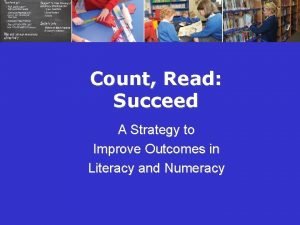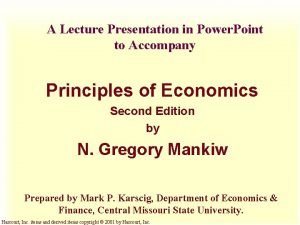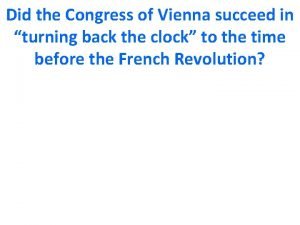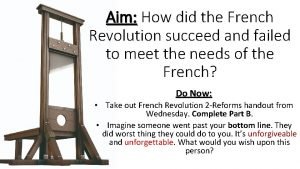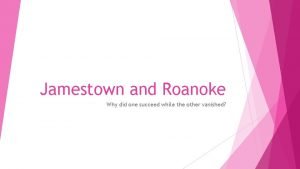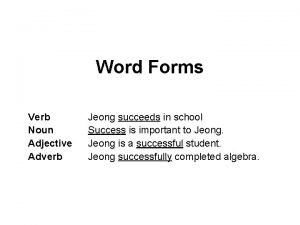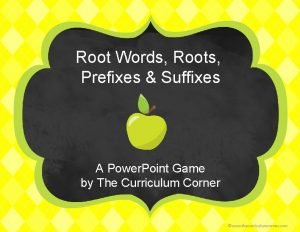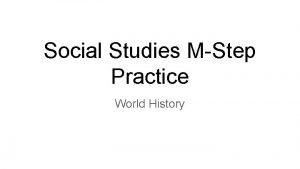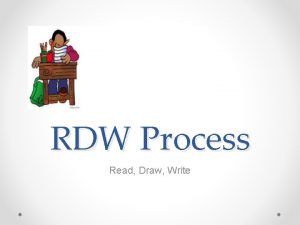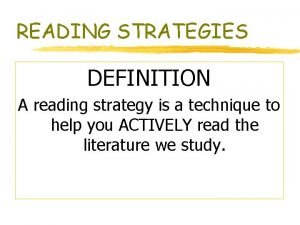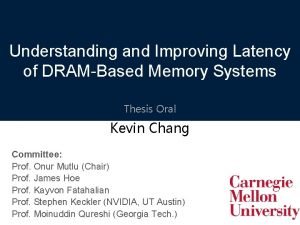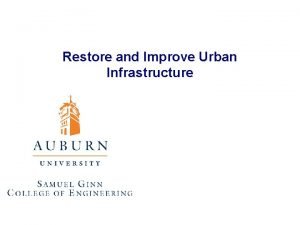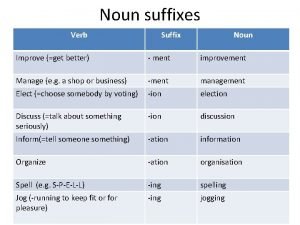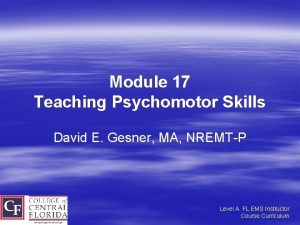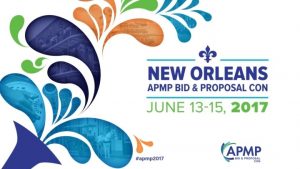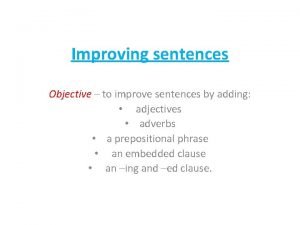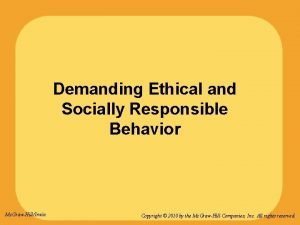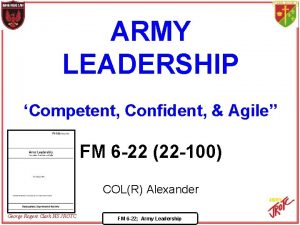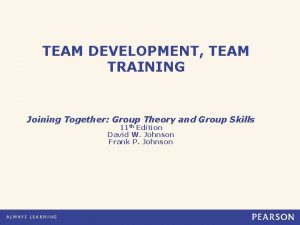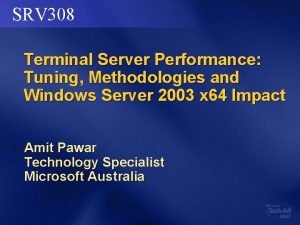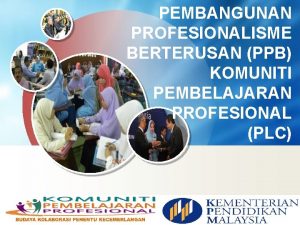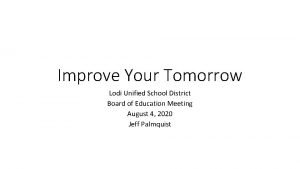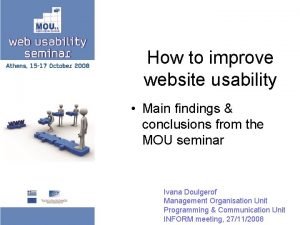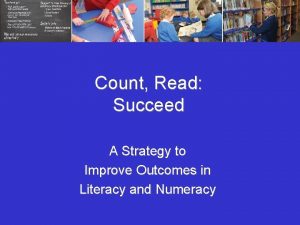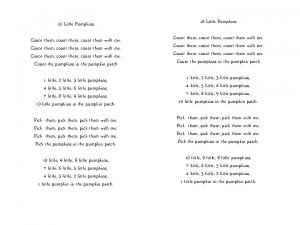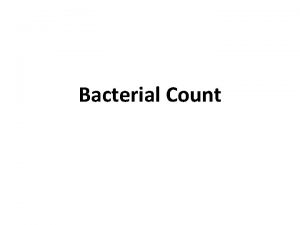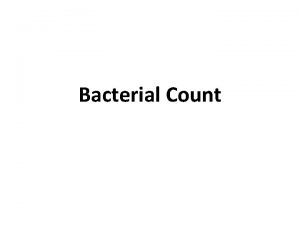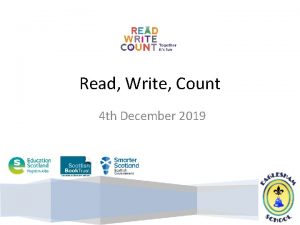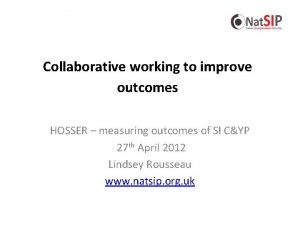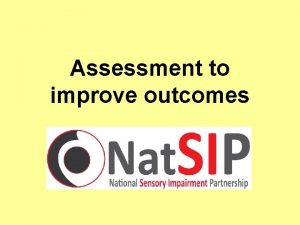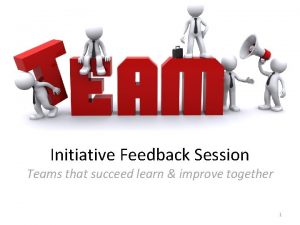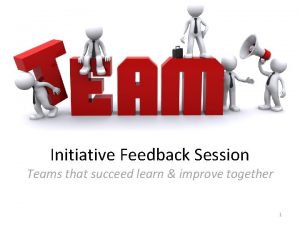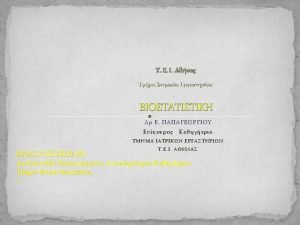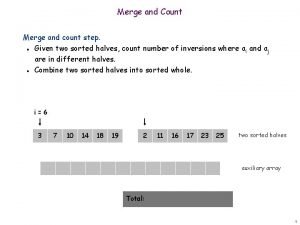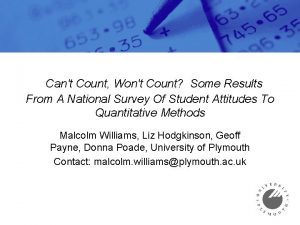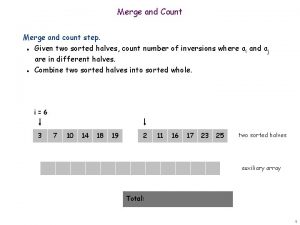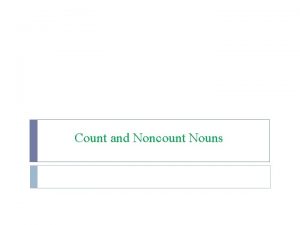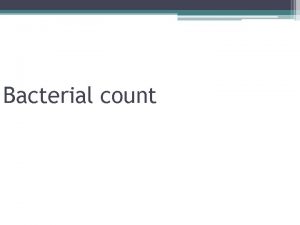Count Read Succeed A Strategy to Improve Outcomes
















































- Slides: 48

Count, Read: Succeed A Strategy to Improve Outcomes in Literacy and Numeracy

Aim • To highlight the key messages of Count, read: succeed

Contents • Overview of Count, read: succeed • What it means for teachers, school leaders and education bodies • What actions need to be taken

Overview - Development • • • Consultation in June 2008 Broad support for approach Some concern over targets Need for greater clarity in language New strategy launched 22 March 2011

Overview of Count, read: succeed • High level strategy • Sets out roles for: – school leaders – teachers – education bodies • Defines literacy, numeracy, underachievement

Literacy is the ability to read and use written information and to write appropriately and legibly, taking account of different purposes, contexts, conventions and audiences. It involves the development of: a) an integrated approach to the acquisition of talking, listening, reading and writing skills across the curriculum; b) knowledge that allows a speaker, writer and reader to use language appropriate to different social situations; c) formal and informal language across all areas of social interaction; and d) the ability to read, understand use information in multiple formats and platforms, including traditional print and on-screen material.

Numeracy is the ability to apply appropriate mathematical skills and knowledge in familiar and unfamiliar contexts and in a range of settings throughout life, including the workplace. It involves the development of: a) b) c) d) an understanding of key mathematical concepts and their inter-connectedness; appropriate reasoning and problem-solving skills; the proficient and appropriate use of methods and procedures (formal and informal, mental and written); and active participation in the exploration of mathematical ideas and models.

• Underachievement is used to describe a situation where performance is below what is expected based on ability. It can apply at the level of an individual pupil or describe a class or school, or indeed a system.

• Low achievement is different from underachievement. Low achievement is where a pupil is achieving to the full extent of her or his ability, but is well below average compared to her or his peers.

Overview of Count, read: succeed Aligns 6 strands 1. 2. 3. 4. 5. Curriculum Assessment Role of teachers Early intervention Schools’ links with parents & communities 6. Sharing best practice

Curriculum • Literacy and numeracy at the heart of the curriculum • Cross-curricular skills of Communication and Using Mathematics

Assessment • Assessment KS 1 – 3 from 2012 against Levels of Progression • Sets expectation every child progresses a Level over the course of a Key Stage.

Schools’ links • Links with parents – encourage parents to support their children • Links with communities – support the work of the school • Schools will be supported to engage parents, particularly those that are “hard to reach”

Targets • Set for 2020 • Milestones along the way

Targets for 2020 • Key Stage 2 – 90%+ • Key Stage 3 – 85%+ • 5+ GCSE A*-C inc English and maths – 70%+ overall; 65% for FSME • 5+ GCSE A*-C inc Gaeilge, English and maths (pupils in IM) – 70%+

Teachers • At the centre of the strategy • Supported in early intervention • Sharing best practice

Teachers • Clarity on – The importance of their professional judgement – Who helps them, and when – Role of phonics – (in post-primaries) Role of Heads of Maths, English and Irish in assessing Using Maths and Communication

Teachers 1. High-quality teaching of all pupils – Work within school literacy and numeracy policy – Have high expectations for all pupils – Track and monitor pupils’ progress

Teachers • Pupils learn in different ways • No single approach suits all pupils • No “silver bullet”

Teachers use their professional judgement – – – Variety of teaching strategies Whole-class teaching Co-operative small group work Individual work Differentiated where appropriate

Teachers “The key question each teacher must consider is whether or not every pupil is fulfilling her or his potential in literacy and numeracy. If the answer is “no” then that pupil is underachieving; the teacher needs to take action to address this and needs to be supported in doing so. ”

Teachers • “To identify underachievement teachers will draw on their professional judgement and the data they consider relevant. It is expected that teachers will mainly use existing assessment information already routinely collected or generated by the teacher or school. Teachers may of course seek additional data where they consider it necessary or useful. ”

Teachers 2. Emerging underachievement – – Teacher decides on the appropriate support Teacher sets targets and identifies actions Time bound From existing resources

Teachers 3. Continuing underachievement (within school) – – – Pupil underachieving despite in-class support Teacher seeks help from within the school Targets set, time-bound actions taken

Teachers • Help from – Coordinator for literacy, numeracy, SEN, newcomer or Traveller pupils – (in post-primaries) a Head of department or head of year – A mentor from within the school – pastoral support staff – The principal, vice-principal or a senior teacher

Teachers 4. Continuing underachievement (with external help) For help from ELBs/ESA – – School must first take all reasonable steps to support the underachieving pupil School must provide a record of support provided to the pupil to date, and evidence that targets are not being met

Teachers • Support is provided to the teacher

Teachers • School can also seek help from: – Other schools – Health professionals

Teachers 5. After a non-statutory assessment – – – Teacher responsible for meeting the pupil’s needs Teacher supported by school leadership External support and resources can be identified by the non-statutory assessment

Heads of English, Irish & maths • Given time and authority to: – Lead on identifying most effective pedagogy – Lead planning for literacy and numeracy involving teachers across the school – Promote sharing of best practice

Heads of English, Irish & maths • Given time and authority to: – Set targets and assess outcomes in literacy and numeracy – Supported by feedback from other departments as appropriate • Expect pupils to normally get A* C in GCSE English and maths, and for Irish-medium, Gaeilge

School leaders • • • Boards of Governors Principals Senior management teams Co-ordinators Heads of departments or years

School leaders • School development plan • Written whole-school policy on literacy and numeracy • Links to families and communities

Principals • Link the SDP and written literacy and numeracy policy to teachers’ development (including PRSD where appropriate) • Culture of accountability re literacy and numeracy

Principals • Ensure staff have high expectations of pupils • Ensure robust tracking and monitoring of pupils’ work • Culture of identifying and sharing good practice

Principals • Ensure the school has a broad and balanced approach to developing literacy and numeracy • In primary schools, ensure systematic phonics course.

Phonics “In developing early literacy skills, pupils need to acquire phonological awareness. Recognising that a broad and balanced approach to promote literacy is key, it is still important that pupils who have not yet full developed their phonological awareness receive a systematic and time-bound programme of high-quality phonics work. ”

Phonics “A range of other strategies for developing literacy should also be deployed as appropriate and pupils who have successfully developed their phonological awareness should not be required to undertake phonics work if the teacher does not think it necessary or beneficial. ”

Principals • All teachers are teachers of literacy and numeracy • Support teachers to ensure sufficient time is spent by pupils developing literacy and numeracy skills

Principals A broad and balanced curriculum is essential to develop well-rounded and welleducated pupils. However, the development of literacy and numeracy skills is of such fundamental importance that teachers and schools will wish to draw on their professional judgement to assure themselves that all their pupils spend the necessary time developing these skills, including through cross-curricular approaches. This will be particularly important where pupils are underachieving and schools may need to prioritise work to develop literacy and numeracy.

Principals • Ensure time and authority for literacy and numeracy coordinators and heads of maths, English, and in IM schools, Irish, to lead planning and assessment throughout the school

Actions • System-wide focus on literacy and numeracy • All education bodies to emphasise this focus – ethos of achievement • Support schools in planning for literacy and numeracy • Accountability throughout education system

Action Plan 2011 -15 • Covers budget period 2011 -2015 • Aim to deliver progress as per milestone targets. • Inspection of support provided to teachers and the implementation of the strategy in 2013/14 and 2015/16

Action Plan 2011 -15 • Implementation of support for teachers from – Pedagogies (from Sept 2011) – Support for teachers as per this strategy, from within school, and from ELBs (then ESA) – Schools need to be aware of their role in supporting teachers to address underachievement

Action Plan 2011 -15 1. Teachers receive high quality support to help them raise standards of literacy and numeracy. 2. Teachers have access to curricular resources that have literacy and numeracy at their core. 3. Teachers have access to examples of best practice in raising literacy and numeracy standards. 4. Teachers get the right help at the right time to tackle underachievement.

5. School Governors are supported in fulfilling their role in raising standards in literacy and numeracy. 6. School leaders supported in leading the raising of standards in literacy and numeracy. 7. Teachers and school leaders can be satisfied as to the quality and relevance of the support available to them

8. Parents get help to support their children’s development of literacy and numeracy. 9. Pupils, parents and society are kept informed about standards of literacy and numeracy. 10. Resources are used as effectively as possible to support raising standards in literacy and numeracy.

• Questions?
 Count read succeed
Count read succeed Governments can sometimes improve market outcomes
Governments can sometimes improve market outcomes Count outcomes
Count outcomes Metternich system
Metternich system How did the french revolution succeed
How did the french revolution succeed Why did roanoke fail and jamestown succeed
Why did roanoke fail and jamestown succeed Succeed noun adjective adverb
Succeed noun adjective adverb Succeed prefix and suffix
Succeed prefix and suffix How to succeed
How to succeed Picture of alliances
Picture of alliances Rdw method math
Rdw method math Reading strategies definition
Reading strategies definition Corporate strategy vs business strategy
Corporate strategy vs business strategy Firms that emphasize global integration make and sell
Firms that emphasize global integration make and sell Production plan example
Production plan example Transnational strategy example
Transnational strategy example Aligning hr strategy with business strategy
Aligning hr strategy with business strategy Transnational strategy vs global strategy
Transnational strategy vs global strategy Masterful strategies come from
Masterful strategies come from Strategy formulation and implementation
Strategy formulation and implementation Listening for specific details top-down or bottom-up
Listening for specific details top-down or bottom-up Strategic management chapter 7
Strategic management chapter 7 International or multinational
International or multinational Decision making unit example
Decision making unit example Improve memory latency
Improve memory latency Soft skills intrapersonal
Soft skills intrapersonal Restore and improve urban infrastructure
Restore and improve urban infrastructure Roce investopedia
Roce investopedia Suffix educate
Suffix educate Suffix
Suffix How to improve psychomotor skills
How to improve psychomotor skills If you don't measure it you can't manage it
If you don't measure it you can't manage it Kiss keep improve start stop
Kiss keep improve start stop Modern software economics
Modern software economics Boring sentences to improve
Boring sentences to improve Need 3. hali
Need 3. hali Www.reachoutworld.org/amc
Www.reachoutworld.org/amc How to improve current ratio
How to improve current ratio Fm6-22
Fm6-22 How did the hongwu emperor improve life for the peasants?
How did the hongwu emperor improve life for the peasants? Joining together as a team to improve the quality
Joining together as a team to improve the quality Improve terminal server performance
Improve terminal server performance What is the difference between spirituality and religion
What is the difference between spirituality and religion Using discussion protocols plc
Using discussion protocols plc How to monitor and improve workplace operations
How to monitor and improve workplace operations How to improve yourself spiritually
How to improve yourself spiritually Lodi unified school district board meeting live
Lodi unified school district board meeting live Improve website usability
Improve website usability Recognition synoynm
Recognition synoynm
